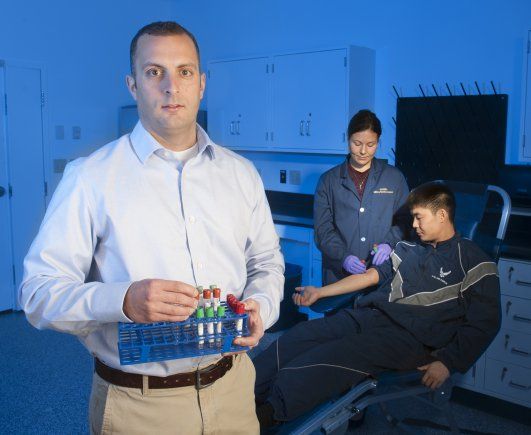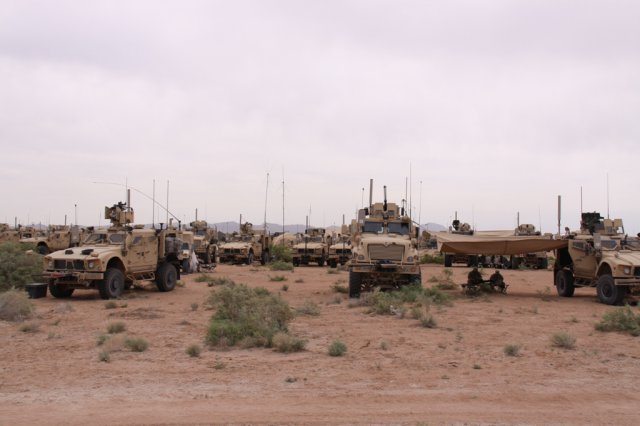Researchers from the U.S. Army Research Institute of Environmental Medicine have teamed up with the Trainee Health Surveillance Flight 559th Medical Group’s Basic Military Training Team at Joint Base San Antonio-Lackland, Texas, to determine whether increased vitamin D and calcium intake can improve bone health in military personnel.
Stress fractures and musculoskeletal injuries are among the leading causes of medical holdovers during basic military training, and often lead to attrition of military personnel early in their careers. As many as five percent of males and 20 percent of females may develop some sort of stress fracture during military training due to the novice warriors’ inability to withstand unaccustomed, repeated stress to their bodies, such as marching with body armor.
“Optimizing bone health of military personnel is essential, especially during Basic Military Training and other military training activities,” explained Dr. James McClung, a nutritional biochemist with USARIEM’s Military Nutrition Division. “These injuries are costly to warfighters and to the military, as a significant portion of individuals that suffer from stress fracture leave military service and stress fracture results in substantial health care costs associated with treatment and rehabilitation.”
Recent studies have linked vitamin D and calcium to bone health and the prevention of stress fractures. In a 2008 study conducted by Creighton University, in conjunction with the Navy, more than 5,000 female recruits underwent a trial in which they consumed either a supplement containing vitamin D and calcium or a placebo over the eight weeks of Navy boot camp.
During the course of that study, 270 stress fractures were observed in the placebo group, but only 226 stress fractures were observed in the group receiving the vitamin D and calcium supplement. Advanced analysis showed that vitamin D and calcium supplementation may have reduced the risk of stress fracture by up to 20 percent.
“We say ‘may have reduced the risk’ because missing from that study were biochemical indicators of nutritional health or functional indicators of bone health,” McClung said. “There were just not enough data to use this study as the sole basis for implementing policy changes affecting vitamin D and calcium levels in the warfighter diet.”
So, McClung and his team of researchers, managed by Dr. Erin Gaffney-Stomberg, a research fellow within the division, set out to explore the biochemical and functional basis for these findings, with the goal of providing Army and Air Force personnel with levels of vitamin D and calcium consistent with the Navy study. After conducting an initial study with the Army in 2012, McClung partnered with the team at JBSA-Lackland in October 2013, for more research.
Air Force recruits, both male and female, participated in a trial similar to the Navy study, but this time they were given a snack bar either fortified with vitamin D and calcium that was developed in collaboration with scientists from the Department of Defense Combat Feeding Directorate at the Natick Soldier Research, Development and Engineering Center, in Natick, Mass., or a placebo snack bar.
McClung’s team of researchers collected physiological data from Airmen twice during their training, on day three of their reception phase of training and again immediately prior to graduation. Techniques included body composition assessment (using military standards), blood collection, a bone scan using a device called a peripheral quantitative computed tomography, and paper surveys. This round of collected data was sent to USARIEM’s headquarters in Natick, Mass., as well Pennington Biomedical Research Institute, Baton Rouge, La., for assessment.
According to McClung, they had close to a 90 percent rate of compliance from Airmen in this study.
“We have had great support from everyone at Lackland for this study, from the leadership to the recruits,” McClung said. “This is important because we have extended the scope of our knowledge beyond the Army, and we now have the basis to extend nutrition recommendations to the Air Force based upon data collected directly from their personnel.”
The leadership at Lackland agrees that this collaboration is valuable and could not have been conducted in partnership with any other organization.
“As I reviewed the military literature on stress fractures and prevention, it was clear that Doctor McClung and the USARIEM team were the only assets in DOD who had published on nutrition and impacts on military training,” said Thomas Leo Cropper, director of Trainee Health Surveillance Flight 559th Medical Group at Lackland. “We consulted them to gain access to the latest military science knowledge on nutrition and military performance to improve military training outcomes.”
According to Cropper, stress fractures are costly because they can require multiple doctor visits and medical tests such as X-rays or MRIs, plus physical therapy, which can cost the Air Force more than $6,000 per case. Added to that, trainees miss weeks to months of expensive military training while they wait to heal in medical hold and then exercise to regain fitness to meet military physical training standards required to graduate.
“Many trainees get demoralized after a stress fracture and quit,” Cropper said. “If we can prevent stress fractures or other injuries, it is much better for all concerned.”
McClung and his team plan to return to Lackland in spring 2014, to continue testing in the hopes of preventing future injuries. At the completion of the study, scientists from USARIEM will share those data with senior leaders from the DOD’s medical and training commands in an effort to determine whether providing vitamin D and calcium beyond the current recommended daily allowance may be beneficial for the optimization of bone health during military training.
“Military personnel represent a unique population faced with sometimes intense physical demands,” McClung said. “Our goal is that findings from these studies will provide the information necessary to determine the optimal vitamin D and calcium requirement of military personnel for the maintenance of bone health and prevention of stress fractures to keep warfighters mission ready for the long haul.”











